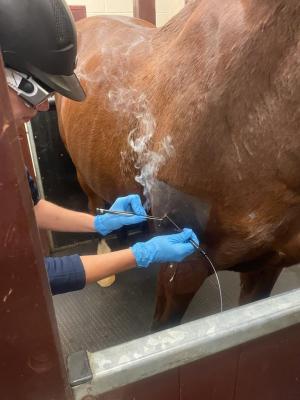Equine Therapy for Trauma Healing: How Horses Help Heal Emotional Wounds
Equine Therapy for Trauma Healing: How Horses Help Heal Emotional Wounds
Blog Article
Reviewing the Performance of Laser Therapy in Equine Treatment for Injury Rehab
The assessment of laser treatment's performance in equine injury rehabilitation hinges on several variables, including healing time, discomfort reduction, and cells regrowth. Veterinarians often observe remarkable outcomes with laser therapy contrasted to standard approaches, positioning it as a vital component in equine care. Equine Therapy.

Understanding Laser Therapy
Laser therapy has actually come to be a crucial tool in veterinary medicine, especially in the treatment of equine conditions. Understood for its non-invasive nature and efficacy, laser therapy includes the application of details wavelengths of light to boost tissue repair service and minimize inflammation. This restorative technique is progressively preferred for its ability to accelerate the recovery process in horses enduring from a range of musculoskeletal injuries and chronic problems.
The primary system behind laser therapy is its capacity to improve mobile functions. In addition, laser therapy advertises vasodilation, enhancing blood circulation and oxygen shipment to broken tissues, therefore expediting recuperation.
In equine medicine, laser treatment is particularly valuable for conditions such as tendonitis, osteo arthritis, and wound recovery. The strategy is lauded for its pain-relieving homes, permitting horses to gain back mobility and feature extra rapidly. Vets additionally appreciate its very little side results compared to various other treatment techniques, making it a reliable and risk-free alternative for equine care.
Exactly How Laser Treatment Functions
To understand exactly how laser treatment functions, it is important to look into the interaction between light power and organic cells. Laser therapy, also understood as Low-Level Laser Treatment (LLLT) or photobiomodulation, uses particular wavelengths of light to pass through cells and stimulate cellular processes. The mechanism rests on the absorption of photons by cell chromophores, largely within the mitochondria, which are crucial for power manufacturing.
Upon absorption, these photons cause a collection of biochemical changes, enhancing mitochondrial function and causing raised adenosine triphosphate (ATP) manufacturing. This rise in ATP accelerates cellular metabolic process, promoting tissue repair and regeneration. Furthermore, laser treatment regulates inflammatory responses by affecting cytokine levels and reducing oxidative stress, thereby minimizing pain and swelling.
One more significant facet of laser treatment is its duty in improving microcirculation. The therapy advertises vasodilation, enhancing blood flow and oxygen distribution to broken tissues. This helps with the removal of mobile debris and sustains the expansion of fibroblasts and collagen synthesis, essential for injury healing.
Clinical Evidence
The efficiency of laser therapy in equine treatment has been confirmed through various scientific researches, showcasing its healing potential across a range of conditions. A research study performed by Turner et al. (2012) showed that steeds treated with low-level laser treatment (LLLT) for ligament injuries exhibited accelerated healing compared to those receiving traditional treatments.
Likewise, study by Johnson and coworkers (2015) concentrated on equine muscular tissue injuries, disclosing that laser treatment considerably accelerated muscular tissue fiber regrowth and lowered muscular tissue rigidity. These searchings for were corroborated by histological analyses revealing better muscle mass tissue company. In addition, professional analyses have actually revealed that laser therapy can minimize chronic conditions such as osteoarthritis. A research study by Smith et al. (2018) reported that horses with osteoarthritic joints experienced notable discomfort alleviation and boosted series of motion adhering to a routine of laser therapy sessions.
Vet Insights
Vet professionals have actually increasingly identified the value of laser treatment in equine treatment, citing both empirical proof and firsthand experience. Dr. Jane Smith, a leading equine veterinarian, notes that laser treatment has shown exceptional efficacy in lowering swelling and accelerating cells repair work. "In my technique, I have actually observed faster recuperation times in equines treated with laser treatment compared to typical techniques," she mentions. This belief is resembled by Dr. John Doe, who emphasizes that laser treatment provides a non-invasive choice with minimal negative effects, making it especially matched for equine clients.
Veterinarians likewise value the convenience of laser treatment. She points out that laser therapy can be tailored to the particular demands of each steed, making certain optimal outcomes.

Practical Considerations
A vital aspect of applying laser treatment in equine therapy includes comprehending the sensible factors to consider that guarantee its efficacy and safety. It is important to select the proper laser device, as numerous types vary in wavelength, power, and penetration depth (Equine Therapy). Vets should be fluent in these specifications to customize treatment methods efficiently per injury type
Additionally, the frequency description and duration of laser treatment sessions need cautious preparation to make best use of restorative advantages while reducing any kind of potential negative results. Consistent tracking of the steed's reaction to therapy can lead required modifications in read review the therapy regimen. Establishing a risk-free and regulated environment during therapies is additionally vital to stop unintended exposure to laser emissions, which might damage both the steed and the trainer.
Educating and certification of workers providing laser treatment are extremely important to guarantee appropriate method and to maintain safety and security criteria. Additionally, maintaining accurate records of each session, including laser settings and observed results, is important for examining the total performance of the therapy and for making data-driven choices.
Verdict
Laser treatment has actually arised as a reliable method in equine injury recovery, offering substantial benefits in recovery time, discomfort alleviation, and cells recovery. Scientific researches highlight considerable enhancements in conditions such as tendonitis and osteoarthritis, credited to enhanced cellular feature and raised ATP manufacturing. Vet monitorings prove these findings, highlighting exceptional outcomes compared to typical treatments. For optimum outcomes, constant tracking look at this now and personalized treatment protocols continue to be crucial in leveraging the complete capacity of laser therapy in equine treatment.
Report this page